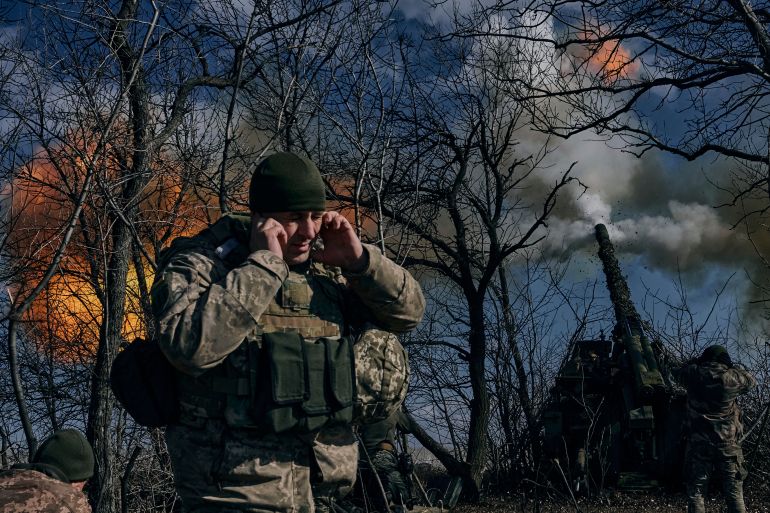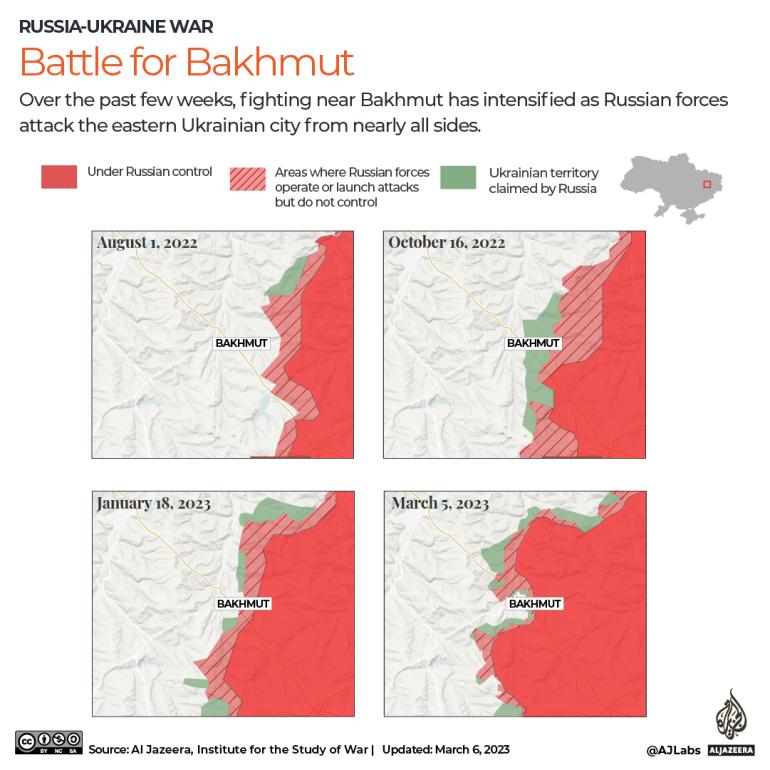What happens if Ukraine retreats from Bakhmut?
The eastern city has long been seen as a prize by Russia but in recent days, Western officials and analysts have questioned its significance.

Kyiv, Ukraine – “Burnt ruins.”
That is what Ukrainian President Volodymyr Zelenskyy said in December during his brief visit to Bakhmut, a largely-destroyed and depopulated southeastern city that has become the epicentre of the Russia-Ukraine war.
Keep reading
list of 3 itemsWagner chief urges Ukraine’s Zelenskyy to abandon Bakhmut
Civilians flee Ukraine’s Bakhmut as battle rages for eastern city
The battle for Bakhmut is one of the bloodiest and longest in the war, which has entered its second year.
According to reports, each day since August, which is when the fight intensified, hundreds of servicemen on both sides are being killed in and around the city.
Even the dry legalese of Ukraine’s official reports cannot hide the colossal scale of hostilities that involve Russian air strikes, artillery and mortar fire, as well as dozens of daily attacks by ground forces.
Russia “is continuing its attempted assault on Bakhmut and surrounding towns” as it shelled more than a dozen locations and as Ukrainian forces repelled almost 100 attacks on Sunday alone, the Ukraine army’s general staff reported on Monday.
Bakhmut’s pre-war population stood at 70,000.
The city is part of a larger agglomeration that includes the town of Soledar, northeast of Bakhmut.
Russia seized Soledar two months ago after its Wagner private army sacrificed tens of thousands of newly-recruited and mostly untrained fighters.
“Nowadays, fighting in Donbas clings to agglomerations,” Kyiv-based analyst Aleksey Kushch told Al Jazeera.
The Bakhmut-Soledar agglomeration is key to seizing other strategically important and heavily fortified cities and towns of Donbas – Chasiv Yar, Kramatorsk and Sloviansk.
However, in recent weeks, Moscow overestimated its capabilities and tried to advance in five directions at once along the front line that stretched some 1,200km (750 miles), according to Ukraine’s top military expert.
“Their efforts are spread too thin,” Lieutenant General Ihor Romanenko, the former deputy chief of the general staff of Ukraine’s armed forces, told Al Jazeera.
Russians are desperately trying to seize the towns of Kreminna, which sits 75km (46 miles) north of Bakhmut, and Vuhledar, 150km (93 miles) to the south of it.
But Kyiv’s forces simply need to hold on for just several more weeks, he said, as they expect the arrival of sophisticated Western arms, including the advanced Leopard tanks designed to fight and destroy Soviet-era armoured vehicles, as well as additional Ukrainian forces trained to use these weapons.
“And after we stop their advancement and form our strategic reserves – taking into account these arms and trained military units – we can talk about conducting a counteroffensive,” Romanenko said.
If Ukraine chooses to withdraw its forces from the nearly-encircled Bakhmut, however, the decision will be far from disastrous.
The city remains important as a centre of Ukrainian forces’ secondary line of defence in Donbas, said Nikolay Mitrokhin, a historian with Germany’s Bremen University.
“But after the loss of Soledar and a virtual surrounding of Bakhmut from three-and-a-half sides out of four, its significance decreased significantly,” he told Al Jazeera. “So, its loss will reflect on the war insignificantly.”
It means, however, that Russian forces will not face serious obstacles before storming Ukraine’s third line of defence, the Toretsk agglomeration that stretches for almost 100km (62 miles) west of Bakhmut, he said.
But with their current speed – considering the resistance of Ukrainian forces and the spring weather with wet and often impassable soil – Russians will lay siege to Chasiv Yar only in the next couple of weeks, Mitrokhin said.
Though he added Moscow’s forces will hardly reach the outskirts of Konstantinovka and Kramatorsk before mid-May. The two strategic towns lie only 27km and 55km (17 and 35 miles) west of Bakhmut, respectively.
“And it will take them a year or more to storm the third line of defence” along the borders of the Donetsk and Luhansk region that includes hundreds of heavily-fortified sites as well as a labyrinth of trenches and shelters, he said.
Western military leaders also think Ukraine’s withdrawal from Bakhmut would not change the war’s odds.
“I think it is more of a symbolic value than it is strategic and operational value,” United States Secretary of Defense Lloyd Austin said on Monday. “The fall of Bakhmut won’t necessarily mean that the Russians have changed the tide of this fight.”
And there is a laundry list of Russia’s shortcomings and miscalculations that will hobble their advancement.
Since the war’s start in February 2022, the Kremlin has stubbornly relied on the obsolete, Soviet-era stratagem of using massive, indiscriminate artillery fire that lacks precision and destroys almost everything in its way.
As a result, Russian forces are now facing a dire shortage of ammunition dubbed “shell starvation”.
The head of the Wagner Group, Yevgeny Prigozhin, has angrily complained about the shortage, accusing Russia’s defence ministry of deliberately sabotaging his requests to get more.
After Pyrrhic losses of manpower, Wagner no longer relies on recruits, while Russia’s top brass dodges the requests of mobilised men and volunteers to join the group, Prigozhin claimed.
A seasoned separatist strongman showered him with criticism.
“It is of utmost necessity to withdraw Prigozhin from the front line and fully forbid him from leading Wagner,” Igor Girkin, a former “defence minister” of separatists in Donetsk, wrote on Telegram on Sunday.
He accused Prigozhin of “political ambitions multiplied by psychopathy, organisation of war crimes, a penchant for shameless and largely false self-promotion and the spread of rotten criminal customs within the military”.
Prigozhin responded by calling Girkin a “fountain of faeces”.
Apart from the infighting, Russia’s efforts in Bakhmut involve a badly coordinated “motley crew”, Lt Gen Romanenko said.
It consists of depleted Wagner units, poorly-trained mobilised men, dwindling regular forces, including paratroopers deployed from Russia’s Pacific coast, and Cossack volunteers who initially succeeded in destroying elite Ukrainian forces.
These days, however, the Cossacks refuse to move forward and are being forced to fight by the Kadyrovtsy forces loyal to Chechnya’s pro-Kremlin ruler Ramzan Kadyrov, Romanenko said.
Moscow is training up to 200,000 mobilised men and is scrambling for enough arms, uniforms and ammunition for them.
But “they overestimated their forces [before] and did it again now”, he concluded.